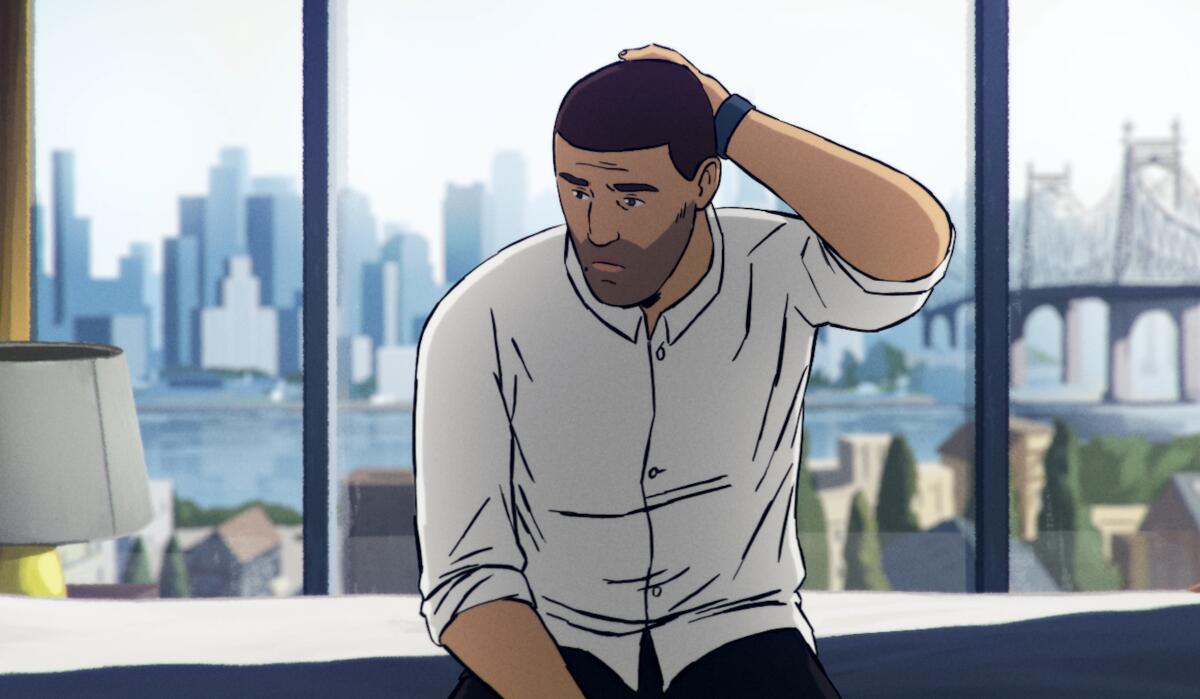Review: In the animated doc ‘Flee,’ a moving portrait of one refugee’s journey to confront the past

- Share via
Amin Nawabi sits for the camera and closes his eyes in the Danish hybrid documentary “Flee” — an intimate portrait of the lasting traumas of displacement and one of the most humane films of the year. He breathes in deeply and the distant memories start trickling out, punctuated in long-ago feelings and details.
First he’s a young boy dancing through the streets of 1980s Kabul, carefree as Western pop music blasts from pink headphones on his ears. Later he sits rapt in the backyard of his family home listening to tales of his father, who’d been taken by the Communist government and would never be seen again. Some time after that, he recalls the shock of fleeing war-torn Afghanistan in 1989 with his mother and siblings — only to be stuck in limbo with expired immigration papers in desolate post-Soviet Russia, watching dubbed Mexican telenovelas to mark the time before mounting ever more harrowing attempts toward a better future.
Decades of lingering anxiety, fear and buried pain reveal themselves as Nawabi, now an academic living in Copenhagen with his boyfriend, recounts his experiences as an Afghani child refugee to director and longtime friend Jonas Poher Rasmussen in “Flee” (the film, which won the Sundance Grand Jury Documentary Prize earlier this year, is also Denmark’s official Oscars entry.)
Rasmussen first met Nawabi (a pseudonym for the subject and co-writer of the film) as middle school students. The film includes his own animated memory of first seeing the guarded young Amin, then a quiet immigrant kid in a strange land trying hard not to be noticed. Now, after decades of close friendship, Rasmussen attempts to record the story of his friend’s early life. He ends up bearing witness to painful truths Nawabi had kept locked deep inside from everyone around him, the film becoming not only testimonial but catalyst for catharsis.
Interspersed with archival news footage and presented mostly in expressive 2-D color animation sequences, “Flee” grounds Nawabi’s recollections in the contexts of the geopolitical clashes that left him, his family and thousands of fellow refugees displaced and desperate enough to risk danger, separation and worse for better lives.
Animating interview sessions conducted over several years and Nawabi’s descriptive memories, “Flee” utilizes the freedom of its format to paint a more complete picture of its subject, his lived experiences and his emotions than might otherwise have been possible. The choice gives buoyance to moments of humor and tenderness, as when Nawabi admits to his boyhood crush on Jean-Claude Van Damme (who, in animated flashback form, winks to him from the poster on his bedroom wall) and revisits a sweet bond with an older boy that bolstered a lonely and perilous episode in his life.
But it’s his vivid memories as a trafficked refugee — smuggled first to Russia, then to Denmark, where he eventually arrived alone and was placed into foster care as a teenager — that fuel some of the most urgent and indelible images, including a shocking display of cruelty on a march through snowy woods and a gutting memory involving a boat filled with hopeful refugees and a passing cruise ship.
“Flee” is a work of great empathy for the refugee experience, bringing audiences close up to the fears of violence and repression that drove Nawabi’s family from their home and the abuse and apathy he describes that they faced once they left. More poignantly it illustrates how deeply the invisible scars can remain etched in those violently fractured from family, home and the promise of safety, even long after the journey is complete.
As he and his family fled from country to country putting their lives into the hands of human traffickers, Nawabi learned to keep his head down, be wary of authority figures and stay alert at all times. Even in animated form, the grief for what was lost along the way is palpable in Nawabi’s voice. It’s noticeable as he reads from his teenage diary, struggling to recognize his own handwriting in his native language as he revisits the detailed account he wrote of the family he lost in Afghanistan, although he doesn’t reveal the true breadth of his emotions until much later.
For Nawabi, the ingrained instinct to repress his identity in the name of self-preservation ran even deeper: As a young man, afraid he’d be rejected by the only family he had if they knew he was gay, he’d kept the truth obscured — a memory he recounts to great dramatic effect in one of the film’s most surprising scenes.
But that kind of lifelong knife’s edge anxiety can be exhausting and destructive. Elsewhere, Rasmussen’s camera captures silent fissures in the otherwise loving home life that Nawabi shares with his partner Kasper, whom he admits to the camera doesn’t yet know all of the dark and painful secrets of his past. The more Kasper pushes for them to put down roots, the more Nawabi puts up walls.
That reluctance, he comes to understand, is tangled up in his sense of guilt over the sacrifices his family made for him to survive. In the film’s gentle final frame, Rasmussen lifts a veil that suggests that his friend, in speaking truth to the past, has finally begun to carve his own path forward.
'Flee'
Rated: PG-13, for thematic content, disturbing images and strong language
Running time: 1 hour, 30 minutes
Playing: AMC Sunset 5, West Hollywood; the Landmark, West Los Angeles
More to Read
Only good movies
Get the Indie Focus newsletter, Mark Olsen's weekly guide to the world of cinema.
You may occasionally receive promotional content from the Los Angeles Times.











